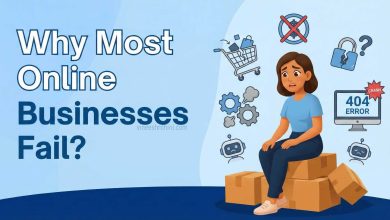How to Set up an Online Store
In today’s digital age, setting up an online store has become increasingly popular as more people turn to e-commerce for buying and selling goods. Creating your online store offers numerous advantages, including reaching a global audience, operating 24/7, and having full control over your business. In this essay, we will provide a step-by-step guide on how to set up an online store.
Get Ready Made Digital Store with 100 Products
From selecting a platform to optimizing your store for success, we will cover all the essential aspects.
- Define Your Business and Target Audience: Before diving into the technical aspects, it’s crucial to define your business and identify your target audience. Ask yourself the following questions:
a. What products or services will you offer?
b. Who is your ideal customer?
c. What differentiates your business from competitors?
d. What goals do you want to achieve with your online store?
Answering these questions will help you shape your brand identity and develop effective marketing strategies.
- Choose the Right E-commerce Platform: Selecting the right e-commerce platform is crucial for building and managing your online store. Consider the following factors when making your decision:
Get 498 Digital Product Ideas eBook
a. Ease of Use: Look for an intuitive platform that allows you to set up and manage your store easily, even if you have limited technical knowledge.
b. Features and Customization: Assess the platform’s features, such as product management, payment gateways, inventory tracking, and customization options. Ensure the platform aligns with your specific business needs.
c. Scalability: Consider the platform’s ability to scale as your business grows. It should accommodate increasing traffic, sales volume, and additional features or integrations.
d. Pricing: Evaluate the platform’s pricing structure, including transaction fees, monthly subscriptions, and any additional costs for add-ons or premium features. Find a balance between affordability and the features you require.
Get 1000+ Readymade Landing Page Templates with Elementor Pro
Popular e-commerce platforms include Shopify, WooCommerce (WordPress plugin), BigCommerce, and Magento.
- Domain Name and Web Hosting: To establish a professional online presence, you’ll need a domain name (e.g., www.yourstore.com) and reliable web hosting. Follow these steps:
a. Choose a Domain Name: Select a domain name that reflects your brand and is easy to remember. Use domain registration services like GoDaddy or Namecheap to secure your domain.
b. Select Web Hosting: Find a web hosting provider that offers reliable performance, fast loading speeds, and excellent customer support. Some popular options include Bluehost, SiteGround, and HostGator.
- Design and Customize Your Store: Creating an appealing and user-friendly design is essential for attracting customers and encouraging conversions. Consider the following design elements:
Get Complete Dropshipping Course
a. Themes and Templates: E-commerce platforms typically provide a range of pre-designed themes and templates. Choose one that matches your brand identity and offers flexibility for customization.
b. Branding and Visuals: Incorporate your brand colors, logo, and visual elements into the design. Use high-quality product images and appealing graphics to enhance the overall aesthetics of your store.
c. User Experience (UX): Ensure your store is easy to navigate, with clear categories, search functionality, and intuitive product listings. Optimize for mobile responsiveness to accommodate mobile users.
d. Payment and Security: Integrate secure payment gateways, such as PayPal or Stripe, to provide a seamless and safe checkout experience for your customers.
- Product Management and Inventory: Efficient product management is crucial for an online store’s success. Consider the following aspects:
a. Product Descriptions: Write compelling and detailed product descriptions that highlight the features, benefits, and unique selling points. Use high-resolution images to showcase your products.
Affiliate Marketing Formula – eBook – 176 Pages
b. Pricing and Discounts: Set competitive prices for your products and consider offering discounts or promotional campaigns to attract customers. Utilize pricing strategies that align with your business goals.
c. Inventory Management: Implement an inventory management system to track stock levels, receive alerts for low inventory, and ensure accurate product availability information.
- Implementing Marketing Strategies: To drive traffic and generate sales, implement effective marketing strategies:
a. Search Engine Optimization (SEO): Optimize your store for search engines by conducting keyword research, optimizing product descriptions and page titles, and improving site speed.
b. Content Marketing: Create informative blog posts, product tutorials, or videos to engage your audience and establish yourself as an expert in your industry.
Affiliate Organic Secrets
c. Social Media Marketing: Utilize social media platforms to promote your products, engage with customers, and run targeted ad campaigns.
d. Email Marketing: Build an email list and create engaging newsletters, exclusive offers, and personalized recommendations to nurture customer relationships and drive repeat purchases.
- Customer Support and Feedback: Offer excellent customer support to build trust and loyalty. Provide multiple channels for customers to reach you, such as email, live chat, or a dedicated support ticket system. Encourage customer feedback and respond promptly to address any concerns or issues.
- Continuous Improvement and Analytics: Regularly analyze your store’s performance using analytics tools like Google Analytics. Track metrics such as website traffic, conversion rates, customer behavior, and sales. Use this data to identify areas for improvement, refine your marketing strategies, and enhance the overall user experience.
ClickBank Success Sale Strategy with Resale Rights

Conclusion
Setting up an online store requires careful planning, attention to detail, and continuous optimization. By following the steps outlined in this essay, you can successfully launch and manage an e-commerce website. Remember to focus on defining your business, selecting the right platform, designing a user-friendly store, implementing effective marketing strategies, and providing excellent customer support. With dedication, perseverance, and continuous improvement, your online store can thrive in the competitive e-commerce landscape.



